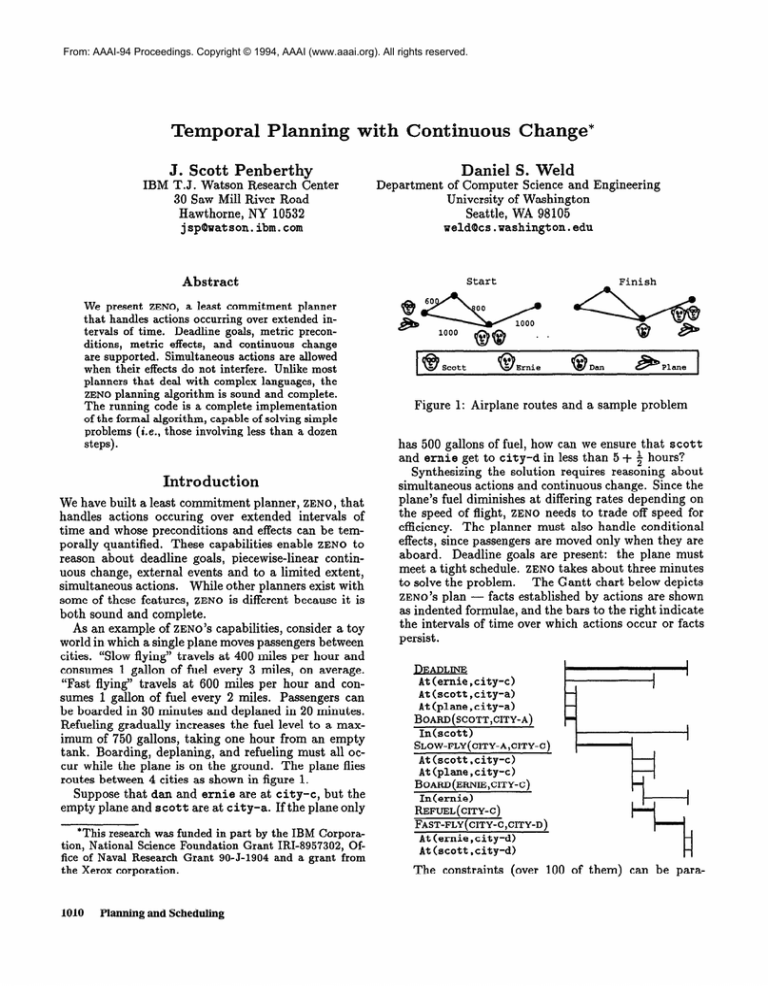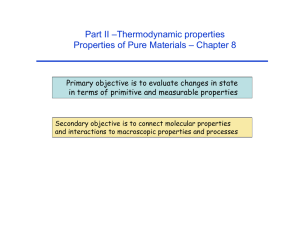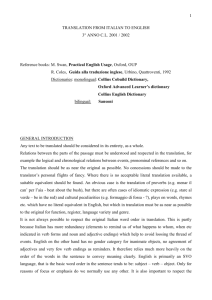
From: AAAI-94 Proceedings. Copyright © 1994, AAAI (www.aaai.org). All rights reserved.
Temporal
Planning with Continuous Change*
J. Scott PenbertRy
Daniel S. Weld
IBM T.J. Watson Research Center
30 Saw Mill River Road
Hawthorne, NY 10532
jspcQwatson. ibm. corn
Department of Computer Science and Engineering
University of Washington
Seattle, WA 98105
neld@cs.washington.edu
Abstract
we present ZENO, a least commitment planner
that handles actions occurring over extended intervals of time. Deadline goals, metric preconditions, metric effects, and continuous change
are supported. Simultaneous actions are alIowed
when their effects do not interfere. Unlike most
planners that deal with complex languages, the
ZENO planning algorithm is sound and complete.
The running code is a complete implementation
of the formal algorithm, capable of solving simple
problems (i.e., those involving less than a dozen
steps).
Introduction
We have built a least commitment planner, ZENQ, that
handles actions occuring over extended intervals of
time and whose preconditions and effects can be temporally quantified. These capabilities enable ZENO to
reason about deadline goals, piecewise-linear continuous change, external events and to a limited extent,
simultaneous actions. While other planners exist with
some of these features, ZENO is different because it is
both sound and complete.
As an example of ZENO'S capabilities, consider a toy
world in which a single plane moves passengers between
cities. “Slow flying” travels at 400 miles per hour and
consumes 1 gallon of fuel every 3 miles, on average.
“Fast flying” travels at 600 miles per hour and consumes 1 gallon of fuel every 2 miles. Passengers can
be boarded in 30 minutes and deplaned in 20 minutes.
Refueling gradually increases the fuel level to a maximum of 750 gallons, taking one hour from an empty
tank. Boarding, deplaning, and refueling must all occur while the plane is on the ground. The plane flies
routes between 4 cities as shown in figure 1.
Suppose that dan and ernie are at city-c,
but the
empty plane and Scott are at city-a.
If the plane only
*This research was funded in part by the IBM Corporation, National Science Foundation Grant IRI-8957302, Office of Naval Research Grant 90-J-1904 and a grant from
the Xerox corporation.
1010
Planning and Scheduling
Start
Finish
Plane
Figure 1: Airplane routes and a sample problem
has 500 gallons of fuel, how can we ensure that Scott
and ernie get to city-d in less than 5 + 3 hours?
Synthesizing the solution requires reasoning about
simultaneous actions and continuous change. Since the
plane’s fuel diminishes at differing rates depending on
the speed of flight, ZENO needs to trade off speed for
efficiency. The planner must also handle conditional
effects, since passengers are moved only when they are
aboard. Deadline goals are present: the plane must
meet a tight schedule. ZENO takes about three minutes
The Gantt chart below depicts
to solve the problem.
ZENO'S plan - facts established by actions are shown
as indented formulae, and the bars to the right indicate
the intervals of time over which actions occur or facts
persist.
DEADLINE
At(ernie,city-c)
At(scott,city-a)
At (plane ,city-a)
BOAFLD(SCOTT,CITY-A)
Inbcott)
SLOW-FLY(CITY-A,CITY-C)
At(scott,city-c)
At(plane,city-c)
BOARD(ERNIE,CITY-C)
Interni@)
REFUEL(CITY-C)
FAST-FLY(CITY-C,CITY-D)
At(ernie,city-d)
At(scott,city-d)
The constraints (over 100 of them) can be para-
composed of logical connectives (A, V) and literals
(f(t, 21.. .xn) = c, R(q . . .zn), or +Z(zr . . .zn)),
disjunction and existential quantification are banned
from action effects. Internally, the conjunctive effects
of each action are simplified to a set of literals through
reduction parsing (Penberthy 1993). This approach
simplifies the matching of action effects to goals. The
last effect conjunct of Fast-Fly,
phrased as follows. Passenger Scott takes 30 minutes
to board the plane at city-a.
Since it doesn’t have
enough fuel to fast-fly,
the plane flies slowly from
city-a
to city-c,
taking 2 hours, 30 minutes. The
plane is refueled over the next hour at city-c;
meanwhile passenger ernie climbs onboard. Note that the
deadline could not be met without scheduling these actions simultaneously. Finally, over the next 1:20, the
plane is flown quickly from city-c
to city-d.
This
leaves 235 gallons of fuel in the plane for a total plan
time of 5 hours, 20 minutes - 10 minutes to spare.
The rest of this paper describes our action and plan
representation, provides an overview of the ZENO algorithm, then discusses formal and empirical aspects.
t/timet if E [is,te]3 & fUel(tj plane) =
Actions and goals
ZENO uses a typed, first-order language with equality
to describe goals and the effects of actions. A pointbased model of time is adopted; temporal functions
and relations use a time point as their first argument.
Quantifiers specify the type of the quantified variable
(i.e., Vtype and 3type >. All types except time are
assumed finite. To represent maintenance (i.e., interval) goals and piecewise-linear continuous effects, one
simply specifies universal quantification over variables
of type time.
A ZENO action schema (e.g., figure 2) characterizes
a set of possible actions with sentences from ZENO'S
Schema Fast-Fly Cm,
at-time: Cts,te3
1)
precondition:
Vtime t t E Ct,, &I >
fuel(t,plane)
> 0 A
at(ts,plane,m)
A
dist Cm, Z>=v2 A mpg(plane)=va
constraints :
v4 = -6OO/us, t, = ts + u2/6OO
effect:
at (t,,plane,0
A
Vtime t t E (t,, &I 3 -at(t, plane, m) A
cvhumanO Vtimet
(t E (t,, t,] A in(t,o)) > lat(t, o,m)A at(t,, o,l)l
t t E Ct,, &I > $ fuel(t, plane) = v4
states that the fuel level will change at a constant rate
of ~4. The value of 214is constrained with additional
equations, relating ~4 to the speed of the plane, 600
miles per hour, and the fuel efficiency, mpg(plane).
We must specify the entire continuous behavior over
the interval [t,, t,], as our semantics insist that all continuous behaviors are the result of direct, explicit action. After an action effect terminates, the last value
obtained by continous change will persist through time
until explicitly modified by another action’s effect.
Plans
plans are triples 4, E, Ck where S is a set of
steps (i. e., instantiated action schemata), L is a set
of causal links, and C is a set of constraints. The constraints in C include metric equations, linear equalities,
linear inequalities, and noncodesignation constraints.
The steps in S are partially ordered by the relevant
temporal constraints in C. The causal links L denote
protection ranges for literals; each link is a pair +L, t9>
where ~9is a literal that must remain true throughout
the interval of time L.
Because preconditions and effects have explicit temporal scope, a planning problem can be encoded as a
partial plan with a single dummy step whose time of
“execution” bounds all planned activity. For example,
our sample problem becomes the dummy step:
ZENO
Schema Dummy
A
Vtime
Figure 2: An action schema for fast flying.
logic. A schema specifies the time over which an action occurs, the preconditions for execution, and the
effects on the world. For example, the precondition
at(t,, plane, m) insists that the plane start at location m at time t, in order to fly from location m to
location 1. The first precondition of Fast-Fly,
vtj_m*t
t E [f8, te]3
v4
fuel(t, plane) > 0
restricts the plane’s fuel level to remain above zero
while flying, but does not commit to a single value:
fuel(t,plane)
may vary throughout the interval
[ts,te]. Wh i 1e a goa 1 may be any quantified sentence
at-time: [to,
t11
precondition:
at(tl,scott,city-d) A at(tl,ernie,city-d)
constraints:
to < t1 5 to + 5.5
effect:
at(to,scott,city-a) A at(to,ernie,city-c) A
at(to,dan,city-c) A fuel(to,plane)=500
This unintuitive encoding of planning problems was
chosen because ZENO'S temporal model eliminated the
need for separate initial and goal steps. When we introduce continuous time into a planning system, initial
conditions, external events and domain axioms become
formally equivalent. They are simply clauses that occur, beyond the program’s control, at specific times.
Final goals and deadline goals are also indistinguishable. They are merely clauses that must be achieved at
a specific time. We lump external events, initial conditions, and domain axioms into the effects of the dummy
action. Deadline goals and final goals are lumped into
Causal-Link Planning
1011
its preconditions. Finally, the time of the dummy action spans the desired time for the plan to complete.
In addition, conditional effects represent external
events that can be disabled, i.e., one can specify that
unless a bomb is disarmed by a specific time, it will
explode. Domain axioms are encoded as universally
quantifed temporal effects.
The Zeno Algorithm
is a least Commitment,
regression planner. It
searches a space whose nodes are pairs +P, G+ where
P is a partially specified plan and G is a goal agenda.
As ZENO traverses arcs, it rewrites complex goals
into simpler ones, satisfies simple goals, imposes constraints, and generates subgoals.
The planner begins at a node where P = -$,L,C+
is a one-step plan encoding the planning problem and
G is the agenda of top-level goals. The algorithm terminates when it finds a node whose agenda is empty
(signifying a solution) or when the plan’s constraints
are inconsistent (failure).
The search process is described as a flow chart in figure 3.
ZEN0
1Is C consistent?
Start:
1
ZFAIL
1 YES
lDoesG=@?l
4 YES
z
Remove a goal
-+o, Q+ from G
Return P.
REDUCE
-+J,L~+
i YES
_No 1Is ‘p metric? 1
Choose source
I
I
ei for -Ccp,L+;
4 YES
Add link -+, cp> to L;
Resolve threats.
POST +, L$Goto Start
Goto Start
Figure 3: The main loop of ZENO.
The full algorithm involves three nondeterministic
decisions: (1) decomposing a complex goal into simpler formula, (2) choosing actions to satisfy simple
goals, and (3) introducing constraints to prevent interference between actions and goals. Completeness
requires backtracking on these decisions - the branching factor is proportional to the number of available
actions and the number of disjunctive goals. Note that
completeness does not require backtracking on goal selection (seen as “Remove a goal” in figure 3). Since
subgoal ordering decisions cm affect planning performance as much as the true nondeterministic
choices,
Planning and Scheduling
Goal
reduction
The reduce procedure simplifies a complex goal by
substituting stronger yet simpler conditions.
A disjunctive goal cpi V . . . V (Pi is replaced, nondeterministically, by one of its disjuncts cpi. A conjunctive goal
(PiA... Ap, is replaced by the set of goals
. . , pn}.
An interval goal )Jtime t t E L > cp is reduced in one
of two ways: either the program splits the interval I
into two subinterval subgoals, or it marks the interval
as indivisible. This allows ZENO to explore all possible
subdivisions of interval goals. Each marked interval
corresponds to a linear segment of a piece-wise linear
equation cp, or it corresponds to a single interpretation of logical literal cp. To avoid infinite branching,
the implementation will only split intervals to a preset depth. This bound restricts the number of actions
that, in combination, can be used to satisfy an interval
goal; iterative deepening search can ensure completeness
A universally
quantified goal Vtypexp,
where
type # time, is replaced by its universal base (Penberthy & Weld 1992; Weld 1994), which is the conjunction of all ground terms cp;, one for each extension
xi of x where xi is a constant of type type. Note that
domains must be finite for this to work; hence we treat
time specially as described in the previous paragraph
and the next section.
Existential quantifiers within the scope of a universal quantifier are replaced with Skolem functions. All
other existentials are treated as simple variable names,
requiring algorithms to handle codesignation and noncodesignation constraints.
Finally, metric constraints on logical fluents, such as
value(t 1, x) 2 value(t2, y) are separated into their
individual components,l yielding e.g.
{cpi,.
.
Goto Start
1012
domain dependent guidance (when available) is useful
for all four types of decisions.
The remaining subsections briefly describe each path
through the main loop. These paths are dispatched
by first testing to see if a goal +cp, L+ remains on the
agenda; if so, it is removed. Note that this tuple format
is representative of the sentence Vtime t t E lg > cp.
ZENO next checks whether cp is primitive, i.e., if it is
a logical literal (e.g., R(zi . . . zn) or iR(a:i . . . zn)),
a metric equality (possibly constraining a fluent, e.g.
f(Xl . ..xn) = v), an arbitrary metric constraint between metric primitives (e.g., vi 5 ~2) or codesignation
.
constraint x M y. Unless cp is primitive, it is reduced
as explained in the next section.
3~1, u2 value(ti,
x) =vi A value(t2,
y) =u2 A vi 5 ~2
‘Although this last transformation may seem trivial,
subtle arguments (Nelson & Oppen 1979; Penberthy 1993)
show that it is necessary to ensure soundness.
Metric
and codesignat
ion goals
If cp is a codesignation
(e.g., x M y or E $ y) or primitive metric constraint
(e.g., z+ ,< uz), it is posted directly to the constraint
reasoning system which determines whether its constraints
are collectively
consistent. The phrase “POST +J, +-" of figure 3 means the
following. If Q is a time point, then only one constraint
‘p is posted, (P(Q). Otherwise,
ZENO exploits piecewise linearity
and posts cp for both endpoints
of the
interval.2 For example, the requirement
that the plane
have fuel 2 0 during flight yields constraints
that the
plane have gas at takeoff and landing. If the constraint
is valid at both endpoints,
the Mean Value Theorem
guarantees
that it will be true for the entire interval.
This approach
works because we limit goals cp to
linear inequalities
and assume that no further decomposition of Q is needed. ZENO handles the case where
Q needs to be divided into subintervals
in the call to
REDUCE, the “goal reduction”
path.
Logical and fluent-definitional
goals
If ‘p from _(‘p, L,$- is a literal such as At (ernie,
city-d),
it is satisfied in a style similar to UCPOP (Penberthy & Weld 1992; Weld 1994) and SNLP (McAllester
& Rosenblitt
1991). in the “logical goals” path of the
chooses a source
main loop. ZEN0 nondetermini&ically
cp over Lo,
for ‘p by finding an effect that concludes
where he possibly precedes 57. Sources from both newly
instantiated
and existing steps Si are considered.
In
are added to c, ensurboth cases, ordering constraints
ing that Lo precedes3 L, in any final plan.
~ENO then protects-the
literal cp over the interval
Lo, where ~~ exactly covers both bg and Lo. This is
accomplished
by first adding a new causal link +, , cp>to .C and then removing all threats to the new link. The
tuple format of a causal link is shorthand
for a logical
sentence stating that cp must persist over the interval
L,,
1993).
. (Penberthy
.
A threat is any effect ek that might possibly cause
~cp over some portion of the interval +. We say “possibly” here since the plan P is only partially
specifled: many step orderings
and values for free variables may be consistent
with P, yet allow threats to
ZENO resolves all threats
using the standard
occur.
techniques
of promotion and demotion,
i.e., posting
ordering constraints
on time points (Chapman
1987),
a new subgoal that
and confrontation,
i.e., posting
prevents
elt: from interfering
(Collins & Pryor 1992;
Penberthy
& Weld 1992; Weld 1994). If no resolution
is possible, ZENO backtracks.
Linking and threat prevention
introduce
constraints
a goal of
on the pian. For example, when achieving
21t is an error for Lg to be anything but a closed interval
of time [tr,t23 or a time point tl, by the definition of goals.
3More exactly, Lo must begin before or coincident with
the start of Lg. Although be may overlap Lg, this is not
required, since ZENO'S threat resolution mechanism ensures
that ‘p persists if there is a gap between he and Lg.
the form fuel(t
,x)= vg(t) with an effect fuel(t
,y>=
Ye(t), ZENO must ensure that x = y and that vg(t) =
ve(t). This ensures that any interpretation
for the variables x and y are consistent with the effect “achieving”
the goal. It also connects the precondition
constraints
on vg(t) to the effect constraints
on ve(t). Similarly, if
fuel(t)
x>= vg(t) were defined by an effect that specified the derivative of fuel( > over [to, tl] to be 6, ZENO
must also constrain vg(t) accordingly,
e.g., by defining
vg(t) = v,(to) + 6 * (t - to) and posting to 5 t 5 tl.
Integrated Constraint Management
Since ZEN0 r&S on constraint
satisfaction
for all temporal and metric aspects reasoning, sound and efficient
algorithms
are essential.
Specialized
routines
cooperate to handle the different types of constraints
in
C: codesignations,
linear equalities, linear inequalities,
and nonlinear
equations.
Codesignations
are handled
as they
were in
UCPOP (Weld 1994).
A simple algorithm
maintains
equivalence
classes of all logical variables, then determines whether the noncodesignations
are inconsistent
with the classification.
Mathematical
formulae posted by ZENO are parsed
dynamically
into a set of linear equations Cp aixi = b,
inequalities
xi aixa < b, and pairwise nonlinear
equations xiyi = c. These canonical forms are identical to
the matrix representation
of equations
used in linear
algebra and operations
research (Karloff 1991).
Linear equations are solved by Gaussian elimination,
linear inequalities
by the Simplex algorithm, and nonlinear equations
are delayed until they become linear
via the solution of other equations
and inequalities.
To ensure sound constraint
handling,
each equality,
is passed to
Xi = c, that is derived by one algorithm
all other algorithms
(Nelson & Oppen 1979).
Determining
an inconsistency
using Gaussian elimination is straightforward;
if a constraint
c = 0 is detected during elimination,
where c is non-zero constant,
then the equations
are inconsistent.
Finding inconsistencies in linear inequalities
is a bit trickier.
Recall that linear programming
is the task of minimizing a cost function while satisfying
a set of linear
inequalities
(Karloff 1991). The Simplex algorithm operates in two phases. First, it constructs
a polytope,
i.e., a convex region in %” , that exactly covers the set
of solutions to the linear inequalities.
In the second
phase, it walks along vertices of the polytope in search
of values that minimize the cost function.
For ZENO,
the optimization
aspect is irrelevant.
Instead,
ZENO
uses the first phase to determine
simply whether the
polytope is malformed.
If the polytope vanishes to the
null vector 6, no solutions
exist and the constraints
are inconsistent.
While exponential
in the worst case,
the expected time for phase I is linear in the number of variables .4 For maximum
speed, ZENO uses Jaf41n our experience, the Simplex algorithm is never the
bottleneck; if larger problems cause this to be the case we
Causal-Link
Planning
1013
far ei.aL’s (Jaffar et al. 1992) dynamic programming
version of the algorithm optimized for incremental updates. This version retains the polytope from n equations, then modifies it when the n + 1st inequality is
added.
The above algorithms determine whether the set
of constraints are consistent.
However, they are not
amenable to the numerous temporal queries required
by the ZENO algorithm. When linking effects to goals
’ or checking for threats, ZENOmust determine whether
two or more intervals overlap.
These intervals, in
turn, are specified as constraints on two end points.
For example, the half-open interval [tr, t2) represents
all time points t such that tl 5 t < tl;Z. To expedite temporal queries, ZENO caches temporal relations
with Warshall’s transitive closure algorithm (Warshall
1962). For each time point t, this cache specifies all
time points t< less than or equal to t, all time points
t> greater th& or equal to t, and all time points t#
d?stinct from t. This can be efficiently implemented
using boolean operations on bit vectors, where each
time point is represented by a unique index.
Formal Properties
Assuming that all interval, metric effects are piecewise
linear, that nontemporal types are static and finite,
and that nonlinear equations can be linearized, then
ZENOis both sound i.e., all plans returned by ZENO will
work, and complete i.e., if a plan exists, ZENO will find
it. The soundness proof introduces a loop invariant
maintained by all control paths of ZENO. The halting
conditions, in combination with the invariant, guarantee that every plan returned by ZENO will work. The
completeness proof uses induction on the number of
steps in a plan. The base case (O-step plans) is true for
all consistent problem descriptions. The inductive case
uses an n - 1 step plan to guide ZENOas it builds an
n step plan.5 ZENO'S proofs occupy many more pa@%
than allowed in this paper; see (Penberthy 1993) for
details.
Performance
has been tested on numerous problems.
Our
empirical results (Penberthy 1993) show that ZENO'S
performance is on a par with state-based planners,
e.g., UCPOP and PRODIGY, in domains that don’t involve interval goals, continuous change and metric relationships (which those planners can’t handle). ZENO'S
speed only degrades when a planning problem demands
ZENO'S advanced features. Yet even in these domains
performance is tolerable, i.e., the current implementation is suitable for experimental research use. Further
work on search control and abstraction is needed before
ZENO can handle large-scale, practical problems.
ZENO
could switch to Karmarkar’s linear programming algorithm
which is guaranteed polynomial (Karloff 1991).
5This clairuoyant proof technique was first used by McDermott (McDermott 1991) to prove his total-order planner complete.
1014
Planning and Scheduling
Figure 4 shows how ZENO performs6 on three such
problems: Allen’s door latch example (Allen et al.
1991), the airplane example of this paper and the metric blocks world problem from figure 9.3 of (Wilkins
1988b). A simple predicate ordering, e.g., see (Sacerdoti 1974), was used on all but the door latch problem
to guide subgoal selection. Iterative-deepening,
depthfirst search (Korf 1985) handled all other nondeterministic choices.
CPU TIME (SEC)
PROBLEM
Door latch
Airplane routing
SIPE example
Figure 4: Execution
0.04
151.56
1.42
f
0.00
=fi 27.56
0.24
f
times for the ZENO planner.
Related Work
Because of our interest in formal properties, ZENO
is closest in spirit to the work of Allen(Allen 1991),
Chapman(Chapman
1987), McAllester(McAllester
&
1986). Allen
Rosenblitt 1991) and Pednault(Pednault
and Pelavin (Allen et al. 1991) describe an elegant theory of temporal planning based on first order logic and
an interval model of time. In contrast, we model time
using the real numbers; this allows metric duration and
continuous change.
Numerous systems with some of ZENO'S features
have been implemented in the past twenty years and
we have drawn insight from many of them.
Drabble’s EXCALIBUR (Drabble 1993) first generates a plan
that ignores metric constraints, then tests it through
qualitiative simulation; failed tests invoke heuristic replanning.
Simmons’ GORDIUS (Simmons 1988) handles actions with conditional and metric effects, but
uses a state-based model of time and is incomplete.
Our approach is considerably simpler than that of
SIPE (Wilkins 1990) and DEVISER (Vere 1983) - ZENO
avoids parallel links, complex traversal schemes, and
heuristic plan evaluation. Similarly, we believe that
ZENO'S treatment of simultaneous and metric effects
is more general than SIPE's. While OPLAN (Currie &
Tate 1991) uses ideas from operations research to optimize resource usage, they use different techniques for
temporal management. In contrast, ZEN0 uses an integrated approach for both temporal and other metric
constraints, but makes no claim of efficient resource
handling.
(Jaffar et al. 1992) developed the incremental algorithms and the idea of using Gaussian elimination and
Simplex phase I iteration to manage linear equations
and inequalities. Our restrictions on the use of metric
variables in ZENO'S logic are derived from the innovative approaches of (Nelson & Oppen 1979) and (Hendrix 1973).
.
‘The experiments were performed on an IBM RS/SOOO
running Allegro Common Lisp; 95% confidence intervals
were calcuated from 10 runs per problem.
Conclusion
ZEN0 isa least commitment, refinement planning algorithm capable of handling simultaneous actions, continuous change, metric reasoning and deadline goals.
Both actions and goals are described in a rich logic
supporting universal quantification, disjunction, conjunction, metric functions, logic functions and formal
objects. The algorithm is sound i.e., all plans returned
as solutions are guaranteed to work. The algorithm
is also complete i.e., if a plan exists, then ZENO will
find it. A full, working implementation of the program has performance similar to existing state-based
planners on comparable domains, but cannot be said
to have heuristic adequacy. We strive for a system
with the performance of SIPE (Wilkins 1988a) and the
formal properties of ZENO. Since metering tools show
that the bulk of ZENO'S time is spent updating and
querying its temporal cache, we hope to integrate optimized temporal reasoners, such as (Dechter, Meiri,
& Pearl 1991),(D ean 1989) or (Williamson & Hanks
1993), into ZENO'S hierarchy of constraint reasoners.
As it stands, we believe that ZENO represents a first
step towards bridging the gap between formal and empirical approaches to automated planning with expressive temporal languages.
Acknowledgments
We thank Tony Barrett, Alan Borning, Ernie Davis,
Denise Draper, Oren Etzioni, Keith Golden, Steve
Hanks, Nick Kushmerick, Edwin Pednault, Ying Sun,
Mike Williamson, and the anonymous reviewers for
helpful comments.
References
Allen, J., Kautz, H., Pelavin, R., and Tenenberg, J.
1991. Reasoning about Plans. San Mateo, CA: Morgan Kaufmann.
Allen, J. 1991. Planning as temporal reasoning. In
Proceedings of the Second International Conference
on Principles of Knowledge Representation and Reasoning, 3-14.
Chapman, D. 1987. Planning for conjunctive goals.
Artificial Intelligence 32(3):333-377.
Collins, G., and Pryor, L. 1992. Achieving the functionality of filter conditions in a partial order planner.
In Proc. 10th Nat. Conf on A.I.
Currie, K., and Tate, A. 1991. O-plan: the open
planning architecture. Artificial Intelligence 52( 1):4986.
Dean, T. 1989. Using Temporal Hierarchies to Efficiently Maintain Large Temporal Databases. Journal
of the ACM 36(4):687-718.
Dechter, R., Meiri, I., and Pearl, J. 1991. Temporal
constraint networks. Artificial Intelligence 49:61-96.
Drabble, B. 1993. Excalibur: a program for planning
and reasoning with processes. Artificial Intelligence
62:1-40.
Hendrix, G. 1973. Modeling simultaneous actions
an continuous processes. Artificial Intelligence 4: 145180.
Jaffar, J., Michaylov, S., Stuckey, P., and Yap, R.
1992. The CLP(R) Language and System. ACM
Transactions on Programming Languages and Systems 14(3):339-395.
Karloff, H.
Birkhauser .
1991.
Linear
Programming.
Boston:
Korf, R. 1985. Depth-first iterative deepening: An
optimal admissible tree search. Artificial Intelligence
27( 1):97-109.
McAllester, D., and Rosenblitt, D. 1991. Systematic
nonlinear planning. In Proc. 9th Nat. Conf. on A.I.,
634-639.
McDermott, D. 1991. Regression planning. International Journal of Intelligent Systems 6:357-416.
Nelson, G., and Oppen, D. C. 1979. Simplification by
cooperating decision procedures. ACM Transactions
on Programming Languages and Systems 1(2):245257.
Pednault, E. 1986. Toward a Mathematical Theory
of Plan Synthesis. Ph.D. Dissertation, Stanford University.
Penberthy, J., and Weld, D. 1992. UCPOP: A sound,
complete, partial order planner for ADL. In Proc.
3rd Int. Conf. on Principles of Knowledge Representation and Reasoning, 103-114.
Available via FTP
from pub/ai/ at cs .-Washington. edu.
Planning with Continuous
Penberthy, J.
1993.
Change. Ph.D. Dissertation, University of Washington. Available as UW CSE Tech Report 93-12-01.
Sacerdoti, E. 1974. Planning in a hierarchy of abstraction spaces. Artificial Intelligence 5:115-135.
Simmons, R. 1988. Combining associational and
causal reasoning to solve interpretation and planning
problems. AI-TR-1048, MIT AI Lab.
Vere, S. 1983. Planning in time: Windows and durations for activities and goals. IEEE Trans. on Pattern
Analysis and Machine Intelligence 5:246-267.
Warshall, S. 1962. A theorem on boolean matrices.
Journal of the ACM9(1).
Weld, D. 1994. An introduction to least-commitment
Available via FTP from
planning. AI Magazine.
pub/ai/ at cs . Washington. edu.
Wilkins, D. 1988a. Causal reasoning in planning.
Computational Intelligence 4(4):373-380.
Wilkins, D. E. 1988b. Practical Planning. San Mateo,
CA: Morgan Kaufmann.
Wilkins, D. 1990. Can AI planners solve practical
problems? Computational Intelligence 6(4):232-246.
Williamson, M., and Hanks, S. 1993. Exploiting domain structure to achieve efficient temporal reasoning. In Proc. 13th Int. Joint Conf. on A.I., 152-157.
Causal-Link Planning
1015






